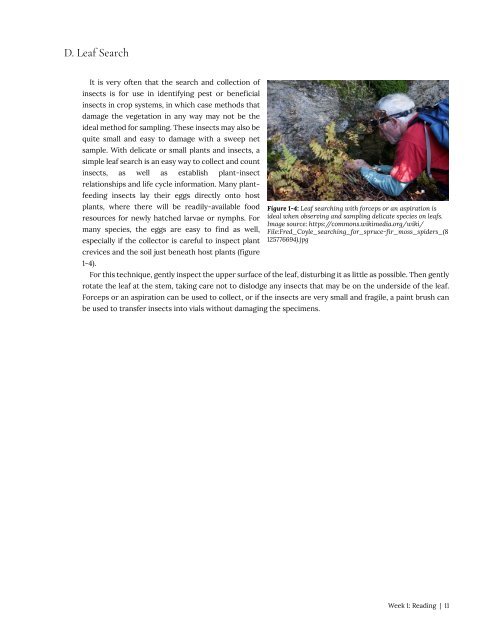Entomology 311 Lab Manual - 1st Edition, 2019
Entomology 311 Lab Manual - 1st Edition, 2019
Entomology 311 Lab Manual - 1st Edition, 2019
Create successful ePaper yourself
Turn your PDF publications into a flip-book with our unique Google optimized e-Paper software.
D. Leaf Search<br />
It is very often that the search and collection of<br />
insects is for use in identifying pest or beneficial<br />
insects in crop systems, in which case methods that<br />
damage the vegetation in any way may not be the<br />
ideal method for sampling. These insects may also be<br />
quite small and easy to damage with a sweep net<br />
sample. With delicate or small plants and insects, a<br />
simple leaf search is an easy way to collect and count<br />
insects, as well as establish plant-insect<br />
relationships and life cycle information. Many plantfeeding<br />
insects lay their eggs directly onto host<br />
plants, where there will be readily-available food<br />
resources for newly hatched larvae or nymphs. For<br />
many species, the eggs are easy to find as well,<br />
especially if the collector is careful to inspect plant<br />
crevices and the soil just beneath host plants (figure<br />
1-4).<br />
Figure 1-4: Leaf searching with forceps or an aspiration is<br />
ideal when observing and sampling delicate species on leafs.<br />
Image source: https://commons.wikimedia.org/wiki/<br />
File:Fred_Coyle_searching_for_spruce-fir_moss_spiders_(8<br />
125776694).jpg<br />
For this technique, gently inspect the upper surface of the leaf, disturbing it as little as possible. Then gently<br />
rotate the leaf at the stem, taking care not to dislodge any insects that may be on the underside of the leaf.<br />
Forceps or an aspiration can be used to collect, or if the insects are very small and fragile, a paint brush can<br />
be used to transfer insects into vials without damaging the specimens.<br />
Week 1: Reading | 11


















